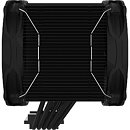Monday, September 3rd 2018
Alpenföhn Intros Two Premium Variants of the Brocken 3 CPU Cooler
Alpenföhn today introduced the 3rd generation Brocken tower-type CPU air coolers in two premium variants - White Edition and Black Edition. These coolers are characterized with a refined anodized aluminium fin-stack design that's more wavy and asymmetric, to minimize sideways "bleeding" of intake air before it passes through the entire area of the fin to pick up heat. The designers also took the opportunity to add a new SECC-steel top-plate, and a fin-stack offset design that improves memory area clearance.
Five 6 mm-thick copper heat-pipes make direct contact with the CPU at the base, conveying heat through the fin-stack, which is then ventilated by a pair of 140 mm fans in push-pull configuration. These Wing Boost 3 fans take in 4-pin PWM input, spin between 400 to 1,500 RPM, pushing 103 m³h of air, with 22 dBA typical noise output, each. The cooler is capable of handling thermal loads of up to 220W, and supports sockets AM4, LGA2066, and LGA115x. Measuring 146 mm x 125 mm x 165 mm (WxDxH), the cooler weighs 1.02 kg, including fans. Available later this month, the Brocken 3 Black Edition and White Edition variants could be priced around 50€ (incl VAT).
Five 6 mm-thick copper heat-pipes make direct contact with the CPU at the base, conveying heat through the fin-stack, which is then ventilated by a pair of 140 mm fans in push-pull configuration. These Wing Boost 3 fans take in 4-pin PWM input, spin between 400 to 1,500 RPM, pushing 103 m³h of air, with 22 dBA typical noise output, each. The cooler is capable of handling thermal loads of up to 220W, and supports sockets AM4, LGA2066, and LGA115x. Measuring 146 mm x 125 mm x 165 mm (WxDxH), the cooler weighs 1.02 kg, including fans. Available later this month, the Brocken 3 Black Edition and White Edition variants could be priced around 50€ (incl VAT).





16 Comments on Alpenföhn Intros Two Premium Variants of the Brocken 3 CPU Cooler
Talk about "unfortunate" naming ...
That said, who cares what it's called, as long as it performs.
I'm sure it's a different language thing: in original language (in this case German) it's a totally normal word but, when translated (in this case English), it sounds as a completely different word with a ... less than good ... meaning.
These look really nice... ...wow - I think they're pretty classy. I'm sure they perform okay but for their size I don't know. Though I guess maybe it's not all that big. Kinda short for 140mm. 220w is respectable if that's really close to what they do - never paid those numbers much mind myself. Benchmarks often say different.
I see only 5 heatpipes, just seems like kind of a waste given that the heatsink can clearly make effective use of 6. Hard to see how they're actually spread from the pictures though. Also... personally I don't trust coatings like that... ...maybe they don't matter all that much but I assume they must shave off at least a few degrees. Always good to see direct contact with copper heatpipes. Finstack is pretty interesting. No problems with airflow through that thing. Makes me wonder if it even needs two fans. Not sure the compromise on surface area is worth it if you're gonna go push-pull anyway... ...unless the fans are really bad. Doesn't seem like they are, though. I dunno, maybe it disperses really well between those little gaps. Cool pockets between might help disperse heat faster - high flux versus high capacity. But still... just feels like if you take every missing plate and add that up, it's a good bit of surface area. Say you squished it down so all of the fins were evenly spaced...
Nevermind, I see now that it's not like that all the way through lol. Just the sides. That's a design choice I get!
Probably another one of those premium midrange coolers. Does a decent job, but mainly functions as a centerpiece. Nothing wrong with that. It's tempting but I'd probably pass.
But that fin stack doesn't look very dense...
My Scythe Kotetsu has a similar arrangement in the fin stack but not as large gaps between the fins as the newer heatsink above.
www.scytheus.com/product/kotetsu-scktt-1000/
Is it really so hard to improve the performance of the air coolers, esp now that we are getting 250W+ heat dissipation with the biggest multi-core chips?
The biggest differences these days are the number of RGB leds and the paintjob.
All these fin arrangement improvements, and small airflow adjustments can´t do much of a difference, since even if you win 10% surface area and have a 5% less turbulent airflow you are all the time still in the limits of your materials air and metal which matter a lot more.
What I would like to see in order to help common coolers out on those 200W chips would be a larger die surface to have more direct transfer surface and a slightly thinner IHS to reduce the distance of energy transfer to the heatpipes. But that´s nothing your cooler can do for you.
Ah well, at some point with 64-core 600W CPUs somebody will finally have an incentive to invent something new. Other than a bigger liquid cooler with a higher surface area radiator :-D
Right now though, these high core count processors are remarkably efficient. Yeah, they draw a lot of power, but when you're feeding 28 cores with 205w, or better yet, 32 cores with 180w, the amount of power each core is drawing is pretty insignificant.